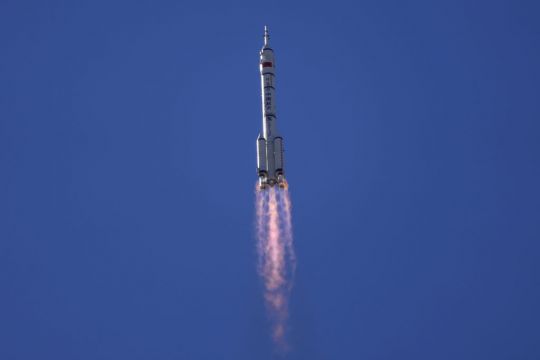A Chinese spaceship carrying a three-man crew docked with China’s new space station at the start of three-month mission on Thursday, marking a milestone in the country’s ambitious space program.
The Shenzhou-12 craft connected with the Tianhe space station module about six hours after take-off from the Jiuquan launch centre on the edge of the Gobi Desert.
The three astronauts are the first to take up residency in the main living module and will carry out experiments, test equipment, conduct maintenance and prepare the station for receiving two laboratory modules next year.
The mission brings to 14 the number of astronauts China has launched into space since 2003, becoming only the third country after the former Soviet Union and the United States to do so on its own.
The astronauts were seen off by space officials, other uniformed military personnel and a crowd of children waving flowers and flags and singing patriotic songs.
The rocket dropped its boosters about two minutes into the flight followed by the cowling surrounding Shenzhou-12 at the top of the rocket. After about 10 minutes, it separated from the rocket’s upper section, extended its solar panels and shortly afterward entered orbit.
About a half-dozen adjustments took place over the following six hours to line up the spaceship for docking with the Tianhe, or Heavenly Harmony, module at about 4pm (8am GMT).
The travel time is down from the two days it took to reach China’s earlier experimental space stations, a result of a “great many breakthroughs and innovations,” the mission’s deputy chief designer, Gao Xu, told the state broadcaster CCTV.
“So the astronauts can have a good rest in space which should make them less tired,” Gao said.

Other improvements include an increase in the number of automated and remote-controlled systems that should “significantly lessen the pressure on the astronauts,” Gao said.
Two astronauts on those past missions were women, and while this first station crew is all male, women are expected to be part of future station crews.
The mission is the third of 11 planned through next year to add the additional sections to the station and send up crews and supplies. A fresh three-member crew and a cargo ship with supplies will be sent in three months.

China is not a participant in the International Space Station, largely as a result of US objections to the Chinese programme’s secrecy and close military ties. However, China has been stepping up cooperation with Russia and a host of other countries, and its station may continue operating beyond the International Space Station, which is reaching the end of its functional life.
China landed a probe on Mars last month that carried a rover, the Zhurong, and earlier landed a probe and rover on the moon’s less explored far side and brought back the first lunar samples by any country’s space programme since the 1970s.
China and Russia this week also unveiled an ambitious plan for a joint International Lunar Research Station running through 2036. That could compete and possibly conflict with the multinational Artemis Accords, a blueprint for space cooperation that supports NASA’s plans to return humans to the moon by 2024 and to launch an historic human mission to Mars.
After the Tianhe was launched in April, the rocket that carried it into space made an uncontrolled re-entry to Earth, though China dismissed criticism of the potential safety hazard. Usually, discarded rocket stages re-enter the atmosphere soon after lift-off, normally over water, and don’t go into orbit.
The rocket used on Thursday is of a different type and the components that will re-enter are expected to burn up long before they could be a danger, said Ji Qiming, assistant director of the China Manned Space Agency.







